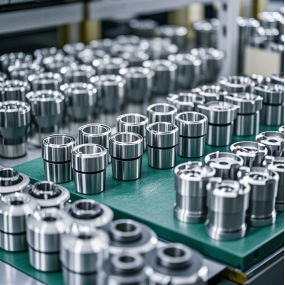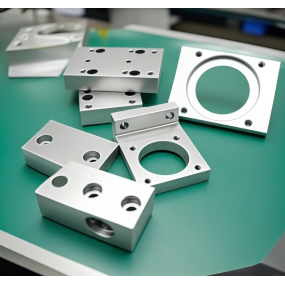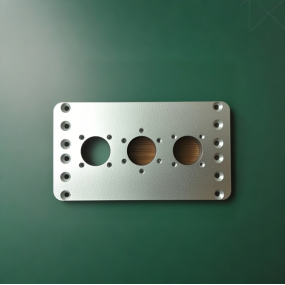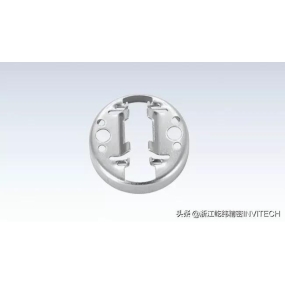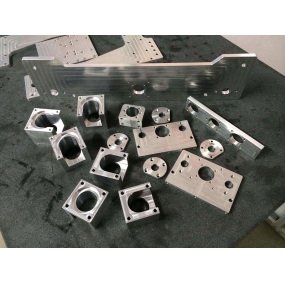The characteristic of metal flow when punching small holes is that at the beginning stage of punching, the waste is compressed by the punch and squeezed into the surrounding area of the hole, which simply causes the deformation of the adjacent hole and the edge of the workpiece shape. When punching small holes, there is a large plastic deformation, so the phenomenon of material hardening and plasticity reduction occurs. Compared with other punching dies, small hole punching dies have their own special features. The diameter of convex and concave dies is small, the punching spacing is narrow, easy to touch, and the punch is easy to break. In order to avoid punch cracking, there are higher requirements for punch dies. In addition to correct and reasonable arrangement of various sizes and orientations, special consideration should be given to the selection of punch materials.
The punch mould planned by the nearby stamping plant is made of steel, and replaceable parts are selected to increase the number of spare parts to avoid cracking the punch and affecting the production.
When planning a small hole die, the following issues should be paid attention to:
1. When planning a punch, its strength should be determined according to the shear strength of the workpiece material. If necessary, a stepped punch can be used to enhance rigidity.
2. The punch should be placed in a symmetrical orientation as much as possible to avoid a large deviation between the center orientation of the punching force and the center of the die handle. The torque should be approximately balanced and not easy to break.  3. When several holes are hedged on the steel plate, the kneading resistance that occurs inside the material between the holes forces the punch to flex in the general direction of the workpiece shape, which increases the friction between the punch and the material, thus causing the discharge force to increase sharply. When punching small holes, the punch should choose a guide device to improve its strength and increase the life of the punch.
3. When several holes are hedged on the steel plate, the kneading resistance that occurs inside the material between the holes forces the punch to flex in the general direction of the workpiece shape, which increases the friction between the punch and the material, thus causing the discharge force to increase sharply. When punching small holes, the punch should choose a guide device to improve its strength and increase the life of the punch.
4. During the work of the punch, in addition to the compressive stress caused by the punching force, it also needs to accept the tensile stress caused by the unloading, and there is a large stress concentration phenomenon at the edge of the punch, especially for the punching of small hole raw materials and harder materials. The phenomenon of fatigue damage occurs when the punch is subjected to cyclic load, which is more outstanding. Therefore, the nearby stamping plant should be particularly careful in the selection of punch materials and the determination of heat treatment specifications, and must take into account the reasonable requirements of both hardness and durability.
5. Try to avoid punch breakage due to small and uneven die gaps, poor precision of stamping equipment, poor die installation, etc. When punching small holes close to the shape of the workpiece, it often causes deformation of the shape summary. The single-sided deformation of the shape summary can cause the end of the punch to twist, causing the punch to break.
Therefore, the orientation of the small hole should be far away from the shape summary, and the orientation of the general hole should be slightly farther away from the shape summary to avoid the deformation of the shape summary.
This article is from EMAR Mold Co., Ltd. For more EMAR related information, please click: www.sjt-ic.com!


 Spanish
Spanish Arabic
Arabic French
French Portuguese
Portuguese Belarusian
Belarusian Japanese
Japanese Russian
Russian Malay
Malay Icelandic
Icelandic Bulgarian
Bulgarian Azerbaijani
Azerbaijani Estonian
Estonian Irish
Irish Polish
Polish Persian
Persian Boolean
Boolean Danish
Danish German
German Filipino
Filipino Finnish
Finnish Korean
Korean Dutch
Dutch Galician
Galician Catalan
Catalan Czech
Czech Croatian
Croatian Latin
Latin Latvian
Latvian Romanian
Romanian Maltese
Maltese Macedonian
Macedonian Norwegian
Norwegian Swedish
Swedish Serbian
Serbian Slovak
Slovak Slovenian
Slovenian Swahili
Swahili Thai
Thai Turkish
Turkish Welsh
Welsh Urdu
Urdu Ukrainian
Ukrainian Greek
Greek Hungarian
Hungarian Italian
Italian Yiddish
Yiddish Indonesian
Indonesian Vietnamese
Vietnamese Haitian Creole
Haitian Creole Spanish Basque
Spanish Basque

